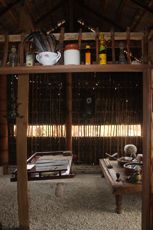A historical mosque in Male’- aged at least 268 years old – has been demolished in order to build a new one on the same site.
‘Fandiyaaru Miskiy’ (Judge’s Mosque) was built by Al Qadi Muhammad Muhibbuddin Fan’diyaaru Kaleyfaanu – who was appointed as Chief Justice in 1747- and was subsequently named after him.
REVIVE, a local NGO working to preserve national history and culture, has condemned the demolition, and expressed remorse over the historical loss.
Describing the demolition as unlawful, the organisation called on the Maldives Police Service, Prosecutor General’s Office, and other authorities to investigate and take action.
REVIVE has also called on the People’s Majlis to pass a national heritage bill as soon as possible.
“The government have an obligation to protect such historical buildings under the 27/79 Act on Historical Places and Things and the UNESCO Convention Concerning The Protection of World Cultural and Natural Heritage,” a REVIVE press release stated.
The organisation also called on relevant authorities to ensure that the digging of the site should be done under the supervision of the Department of Heritage, as historical relics are often found under such sites.
Male’ city council member Ibrahim Shuja said that the mosque was demolished to build a modern four-storey mosque ‘ for the benefit of the people’.
“A generous businessman has offered to build a new mosque there, they have been planning this for three years. It was discussed with the [city] council and the Islamic Ministry before we approved it. We are not doing anything illegal here. It is a mosque we are building, not a carnival. We will go on with the project as planned,” Shuja said.
He also said there was “not that much of history”, that the corpses buried there would be removed, and that the place would be cleaned for building the new mosque.
“If anyone wants to observe, they are welcome. And if anyone wants the wooden structure of the ceiling, they can take it,” he said.
Director of the Department of Heritage Ali Waheed confirmed that the department was not informed about the demolition of the mosque. He noted that while there is no heritage law requiring such approval, considering the department is mandated with taking care of such sites, the usual practice is to consult with it before such activity.
“Even if it is to place a telecommunication antenna near a historical site, we are consulted usually. But we haven’t been officially informed about Fandiyaaru Miskiy,” Waheed said.
Ali Waheed noted that the department has a number of challenges in taking care of historical sites around the country, including the fact that such places are under the jurisdiction of Island Councils with budget deficiencies.
“We have earlier paid people from islands to maintain such places, but since we can no longer pay for the maintenance, those places haven’t been maintained for the past four years. And not all councils are cooperative in maintaining such places,” Waheed said.
Mohamed Shatir, Historian and Director General of the National Archives also expressed concern over the demolition.
“Personally, I feel that it shouldn’t have been demolished. If there was a need to expand the mosque, I think it could have been done while retaining the original old mosque. Perhaps it is not exactly unlawful as there is no proper heritage act in place, but it is definitely not right,” Shathir said.
According to REVIVE, a seven foot tombstone within the mosque premises was also demolished in early 2000s, while the greater cemetery was dismantled in 1970 to provide housing plots.
REVIVE president Ahmed Naufal said that other historical sites such as Koagannu Cemetery in Addu City – one of the oldest in the country- and the cemetery of the old Friday mosque in Male’ have also been vandalised.
“In most islands such places are abandoned and ignored. Not just by the authorities but also members of the public don’t seem to care about such places,” he said.
“We are working on a National Heritage Bill currently. But I really don’t think laws alone will get results. The Maldives National Archives Act was passed in 2011, and they still have only a few staff and no office,” he said.
Referring to the religious extremists’ destruction of historical Buddhist relics at the Maldives National Museum in 2012, Naufal said that even after the incident the security of the museum is poor.
“These are national treasures. They represent our history and our culture. They should be properly protected, perhaps by our national security forces. A lone security guard is not enough, especially considering the place was attacked recently,” said Naufal.
 (0)Dislikes
(0)Dislikes (0)
(0)